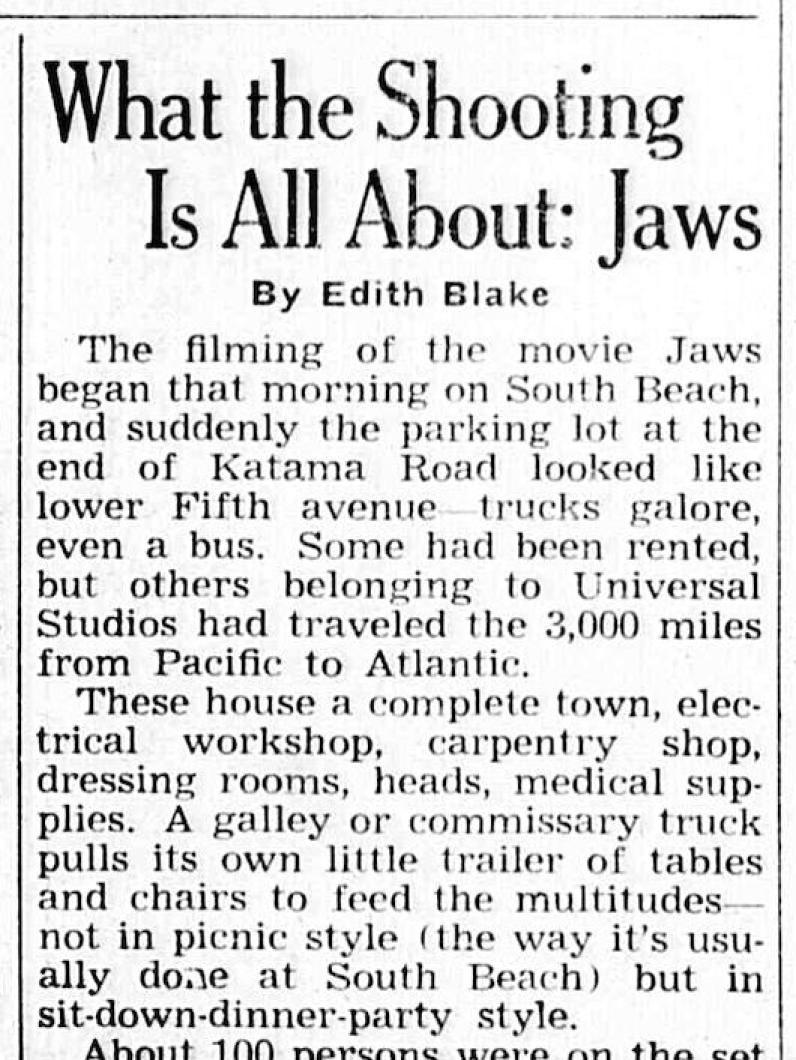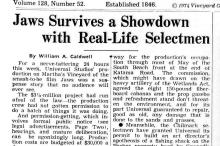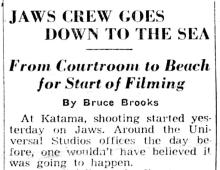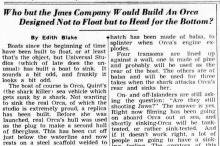The filming of the movie Jaws began that morning on South Beach, and suddenly the parking lot at the end of Katama Road looked like lower Fifth avenue — trucks galore, even a bus. Some had been rented, but others belonging to Universal Studios had traveled the 3,000 miles from Pacific to Atlantic.
These house a complete town, electrical workshop, carpentry shop, dressing rooms, heads, medical supplies. A gallery or commissary truck pulls its own little trailer of tables and chairs to feed the multitudes — not in picnic style (the way it’s usually done at South Beach) but in sit-down-dinner-party style.
About 100 persons were on the set (really a dune) working at a leisurely pace, with a subtle sense of excitement, but all horribly well organized.
The legal action surrounding the construction of sets at the Norton and Easterbrooks boat shed on Fuller street is drawing toward resolution. Here is the way things stand:
On April 29, in District Court, special Justice Philip M. Boudreay found that the issuance of a complaint was in order charging the boat yard and the studio with violation of the zoning by-law. (Judge Boudreau did not make a decision in the case, nor did he impose a fine, as was reported last week: he simply found that there was just cause for the complain to be issued.)
However, no action has followed that decision. Instead, there will be a hearing at 6:30 o’clock tonight in the town hall on Universal’s application for a variance, which would allow the studio to build sets on the premises for a certain specified period. No further court hearings have been scheduled.
Miss Shari Rhodes has been on the Island for several weeks selecting New England faces, and on the theory that the best performer of a man’s role is the man himself, she cast Robert J. Carroll and Cyprien P. R. Dube as selectmen, which they’ve been, and summer people are playing summer people. In a nautically oriented community the populace has been cast as people who, for pleasure or pence, just naturally take to the briny. As such they sally forth with spear, harpoon, rifle, picnic hamper, dynamite, six-pack, fishing pole, or bow and arrow at the ready.
The first day’s Katama shooting covered the discovery of the fabricated “remains” (which got toted around in a blue plastic bag most of the day) of a girl killed by the shark and the closing of the beaches to swimmers.
A Rehearsal
The first scene was rehearsed a few hundred times not only to drill Roy Scheider, late of the French Connection, who plays the police chief, and Jonathan Filley of Chilmark, whose girl gets sharked, but also to give the cameramen and light crews some practice in their intricate maneuvers. It was shot about 20 times after that.
To the constantly changing supply of sidewalk superintendents all the takes looked perfect. Before each of them the director, Steven Spielberg, would yell, “Quiet! Ready to roll — no, wait a moment. Bill, give us some seagulls,” and Bill, behind a dune, would throw out bread until the Katama gulls for the first time in their lives were sated.
To lend a lonely air to the mob-tracked beach, footprints were swept away with brooms.
The second day’s shooting had the aspects of a social event at the end of the long winter. Islanders who hadn’t seen each other throughout the dullness chatted as they watched and worked.
This is the scene in which all manner of humanity, with all manner of equipment, in all manner of craft (none of it looking seaworthy), takes to the sea to rid it of the white shark bound on ruining the summer’s economy.
Woodrow Wilson Sayre sports a large rifle and a small net; Mrs. Williams C. Bowie, in white pants and cyclamen slicker, totes a picnic basket chic enough for a Pickwick picnic; John Alley bellows at people usurping his right to the gas dock; Stanley Hart, dressed in an inappropriate sports jacket, is the perfect gentleman helping far too many persons into a far too small craft; Allen Miller sharpens an antiquated harpoon; John Painter looks fierce under bullets and guns; Bill O’Gorman staggers with strings of dynamite; and Donald Poole, as harbormaster, munches a bowl of cold cereal.
Willis Gifford, who arrived spotless in new sneakers and creased trousers, was instantly attacked by the make-up man with dirt in an aerosol can, then handed a fishing rod to go for minnows. Charles J. Blair managed to lose his fishing rod and was docked his first day’s pay of $25 for losing a prop.
The first scene on the dock was shot 14 times. “No wonder they all go nuts out in Hollywood,” one Islander remarked.
Then the rains came.
After buying Norton & Easterbrooks and Turf and Tackle out of foul-weather gear and 10 hours of work on the set (rain or no rain) they had shot 140 seconds of film for the movie.
The next day was Saturday and sightseers added themselves to the crowd on the dock. More scenes were taken for background. Mrs. Charles J. Blair say in her prop (a boat) and did a crossword puzzle. Robert Shaw arrived from Ireland to play Quint, the shark killer; Darryl Zanuck mushed about the set; and Eleanor Harvey spent another day cramped in a boat almost too small to float.
Teddy Grossman, who plays a drunk, staggered down the dock with an ice bucket and huge bag of popcorn. To the tune of the director yelling, “funnier!” he staggered forward, swayed in the breeze, boarded a boat, tripped over the painter backward, and sailed into the drink.
Monday found the little fleet offshore bouncing and bounding in gray seas so angry that only two takes were made before the armada returned to the harbor and the camera moved to the stability of Jaws headquarters in the Christine Pease house, where filming was done in the mini-police station.
Next day the fleet sailed again. The weather wasn’t much better, but the water was less bumpy, so they got on with filming. In the process the Flicka sank (which was supposed to happen) and was then pumped and raised in case retakes were needed. She is now scarred with shark tooth marks along her gunwale.
A B.B.C. company arrived that day to do a documentary on the filming, and in the process of leaping from one boat to another one of the actors missed.
Wednesday the armada worked off Cape Pogue and the extras chummed for the shark. Production didn’t know when the chum (scup, bass and leftover meat) would be needed; so it had been kept handy on the dock, in the sun, since Friday. So-o-o, well, to say the least it was fragrant, and to make it even more unattractive makeup men had made up the chum with blood by Max Factor.
After all this smelly fish on the bouncy briny it is a wonder that anyone could eat lunch, but this was served on those long tables at the boat yard.
For some of the scenes on board boats they are using a small Panavision camera which cannot be purchased but must be rented — for a rumored sum of $1,200 a week. At the end of each day’s shooting the film is flown to California and the Technicolor labs where it is developed and prints, made from the negatives, are posted back. These are called dailies. The first day’s takes gave been screened, and, said Miss Barbara Bass, the second assistant director, they’re good, “very good”.
Wednesday afternoon Mrs. Daniel Hull was promoted from status as an extra to a “day playing part,” which means she spoke. She and Richard Hewitt each thought they had hooked the shark, but they had only hooked each other. Cherry bombs were used to sound like rifle shots, but they weren’t loud enough at sea; so Lord only knows what they will use next. Already people ashore were claiming they had seen depth charges.
The mechanical and real sharks have not yet arrived. The immediate future shooting is scheduled in the mock police station, which has just been renovated into a morgue.










Comments